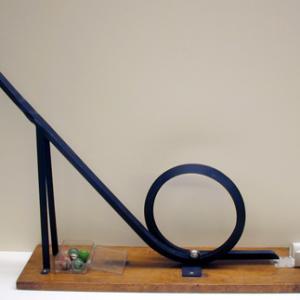College of Liberal Arts & Sciences
1M40.20 - Loop-the-Loop
Start with the smooth steel ball and observe that you have to start it at the very top of the track for it to make it around the loop. With the scuffed steel ball you should be able to start the ball at 3/4 height and still make it around the loop. This is because the smooth ball loses some energy to sliding friction before it starts to roll. The scuffed ball starts to roll almost immediately.
- Roseli Constantino Schwerz, Adriana da Silva Fontes, Andre Luis Schwerz, "Rolling with Slipping and Transition to Pure Rolling on an Inclined Plane", TPT, Vol. 62, #2, Feb. 2024, p. 132.
- Rod Cross, "Rolling and Sliding Down an Inclined Plane", TPT, Vol. 61, #7, Oct. 2023, p. 568.
- Glenn Wagner, "A Circular Motion Activity with Hot Wheels Rev-Ups", TPT, Vol. 47, # 2, Feb. 2009, p. 119.
- Alan Cromer, "An Unusual Rolling-Sphere Phenomenon", TPT, Vol. 34, # 1, p. 48- 50, Jan. 1996.
- Christopher R. Hazard, Joseph A. Sicking, and Terrence P. Toepker, "But Where Does It Land?", TPT, Vol. 32, #1, Jan. 1994, p. 48.
- George W. Ficken, Jr., "A Hoop, Not a Cylinder", TPT, Vol. 32, # 4, Apr. 1994, p. 197.
- Terrence P. Toepker, "Thanks, Readers!", TPT, Vol. 32, # 4, Apr. 1994, p. 197.
- Roger E. Mills, "Miracle Mileage Versus the Conservation of Energy", TPT, Vol. 21, # 1, p. 45, January 1983.
- Kelvin Bruan, Fr. Earl W. Meyer, Angelo Armenti, Jr., "Could an Athlete Run a 3-m Radius "Loop-the -Loop?", TPT, Vol. 19, # 9, Dec. 1981, p. 624.
- Rod Cross, "Sliding and Rolling Along Circular Tracks in a Vertical Plane", AJP, Vol. 91, #5, May 2023, p. 351.
- Karl C. Mamola, William A. (Toby) Dittrich, "Energy Loss and Jerk on the Loop-the-Loop", AJP, Vol. 89, #6, June 2021, p. 583.
- Waldemar Klobus, "Motion on a Vertical Loop with Friction", AJP, Vol. 79, # 9, Sep. 2011, p. 913.
- Thomas B. Greenslade Jr, "Loop-the-Loop", AJP, Vo. 79, # 6, June 2011, p. 643.
- M. E. Bacon, "How Balls Roll Off Tables", AJP, Vol. 73, # 8, Aug. 2005, p. 722.
- Peter L. Tea, Jr., "Trouble on the Loop- the- Loop", AJP, Vol. 55, # 9, Sept. 1987, p. 826.
- R. A. Bachman, "Sphere Rolling Down a Grooved Track", AJP, Vol. 53, # 8, August 1985.
- Oleg Jefimenko, "Water Stream "Loop-the-Loop", AJP, Vol. 42, # 2, Feb. 1974, p. 103.
- Mm- 5, Freier and Anderson, A Demonstration Handbook for Physics.
- M- 422, "Hot Wheels Loop-the-Loop", DICK and RAE Physics Demo Notebook.
- M- 674, "Loop the Loop", DICK and RAE Physics Demo Notebook.
- M-157, Richard Manliffe Sutton, Demonstration Experiments in Physics.
- Robert Ehrlich, "E.5, Loop-the-Loop On an Incline", Turning the World Inside Out, p. 57.
- Donna Berry Conner, "Loops From Cove Molding", A Potpourri of Physics Teaching Ideas, p. 12.
- George M. Hopkins, "Centrifugal Force", Experimental Science, p. 10.
- David Kutliroff, "41, Centripetal Force Demonstration with a Pendulum", 101 Classroom Demonstrations and Experiments For Physics Teachers, p. 93.
- Janice VanCleave, "4, Up and Down", Engineering For Every Kid: Easy Activities That Make Learning Science Fun", p. 27.
- Borislaw Bilash II, David Maiullo, "Loop the Loop", A Demo a Day: A Year of Physics Demonstrations, p. 140.
- Jearl Walker, "1.20, Circus Loop-the-Loop Acts", The Flying Circus of Physics Ed. 2, p. 9.
- Julius Sumner Miller, Physics Fun and Demonstrations, p. 105.
- Curt Suplee, "Energy to Spare", Everyday Science Explained, National Geographic, p. 24.
- Joseph Frick, "#4 - Loop the Loop", Physical Technics: Or, Practical Instructions for Making Experiments in Physics and the Construction of Physical Apparatus with the Most Limited Means", p. 142.
Disclaimer: These demonstrations are provided only for illustrative use by persons affiliated with The University of Iowa and only under the direction of a trained instructor or physicist. The University of Iowa is not responsible for demonstrations performed by those using their own equipment or who choose to use this reference material for their own purpose. The demonstrations included here are within the public domain and can be found in materials contained in libraries, bookstores, and through electronic sources. Performing all or any portion of any of these demonstrations, with or without revisions not depicted here entails inherent risks. These risks include, without limitation, bodily injury (and possibly death), including risks to health that may be temporary or permanent and that may exacerbate a pre-existing medical condition; and property loss or damage. Anyone performing any part of these demonstrations, even with revisions, knowingly and voluntarily assumes all risks associated with them.
